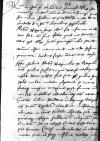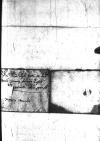Quae hic nova habemus, pro debito meo et voluntate Dominationi Vestrae Reverendissimae brevibus explicabo. ⌊Maiestas regia senex⌋ iterum fit infirma, ut illa aetas fert, non sine febre, quod me terret. Deus Optimus Maximus sanctum ⌊principem⌋ nobis servet. Dominorum adhuc nemo venit nec video hospitia procurari, tardius forsan convenient etc.
Heri habuit ⌊maiestas reginalis⌋ ex ⌊Neapoli⌋ litteras, quibus scribitur, quomodo mense Octobris illi insoliti terrae motus facti sint, Q quibus ⌊Puteolis⌋ multa mutata. Aperuit se mons factaque magna voragine, exiit fumus cum multis cineribus obtenebravitque totum aerem. Cineres lubrici decideru<n>t undequaque, ⌊Neapoli⌋ visi duorum digitorum latitudine, ⌊Sulfotara⌋ et hidden by binding⌈[t]t hidden by binding⌉ ⌊Alumera⌋ ac lacus Sibillae absorbta sunt, apparentque vestigia habitationum antiquorum seu civitatum, termae collapsae, civitas dishabitatur prae timore. Curiosi multi volentes omnia videre mortui sunt ob hocque inhibuit vicerex, ne  AAWO, AB, D.68, f. 196v aliquis in illas partes audeat ire. Omnia, quae hidden by binding⌈[uae]uae hidden by binding⌉ Italicis verbis ⌊maiestati suae⌋ scripta sunt, longe hidden by binding⌈[e]e hidden by binding⌉ esset repetere, in quanto terrore sit tota ⌊Neapolis⌋ quantumque metum cripta eis faciat hidden by binding⌈[at]at hidden by binding⌉.
AAWO, AB, D.68, f. 196v aliquis in illas partes audeat ire. Omnia, quae hidden by binding⌈[uae]uae hidden by binding⌉ Italicis verbis ⌊maiestati suae⌋ scripta sunt, longe hidden by binding⌈[e]e hidden by binding⌉ esset repetere, in quanto terrore sit tota ⌊Neapolis⌋ quantumque metum cripta eis faciat hidden by binding⌈[at]at hidden by binding⌉.
⌊Andreas Doria⌋ cum don ⌊Fernando de Gonzaga hidden by binding⌈[nzaga]nzaga hidden by binding⌉⌋ aliisque proceribus multis hostes classe aggres hidden by binding⌈[res]res hidden by binding⌉sus, ⌊Venetorum⌋ autem capitanei timidius [...] hidden by binding⌈[...][...] hidden by binding⌉ eorum observantes in causa fuerunt, ut Christiani hidden by binding⌈[stiani]stiani hidden by binding⌉ damnum passi sint. Quare deinceps ⌊Andrea hidden by binding⌈[a]a hidden by binding⌉ Doria⌋ vult suos capitaneos super eorum classe hidden by binding⌈[sse]sse hidden by binding⌉ habere. Haec no stain⌈[o]o stain⌉va non publicantur cla[...] hidden by binding⌈[...][...] hidden by binding⌉ quomodo nostris successerit.
Ego desidero carnes dolendas in ⌊patria hidden by binding⌈[a]a hidden by binding⌉⌋ habere. Nil restat dignum scitu. Commendo me iterum Dominationi Vestrae Reverendissimae, quae felicissime hidden by binding⌈[ime]ime hidden by binding⌉ valeat.
 AAWO, AB, D.68, f. [1] after 196
AAWO, AB, D.68, f. [1] after 196
 AAWO, AB, D.68, f. 196v aliquis in illas partes audeat ire. Omnia, quae hidden by binding⌈[uae]uae hidden by binding⌉ Italicis verbis
AAWO, AB, D.68, f. 196v aliquis in illas partes audeat ire. Omnia, quae hidden by binding⌈[uae]uae hidden by binding⌉ Italicis verbis 

